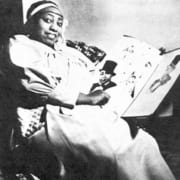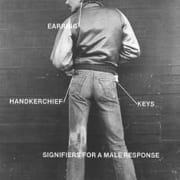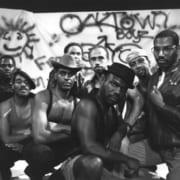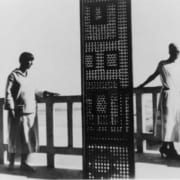Jerome Caja – Exhibition Notes
National Queer Arts Festival 2000 Visual Arts Exhibition, SomArts, San Francisco
ODYSSEY AND UNDERWORLD
The Art of Jerome Caja, Charles Sexton, and Thomas Plagemann
The three artists who have been drawn together for this exhibition employ distinctly different methods to reveal the erosion of culture that marked the end of the twentieth century and continues to threaten us. These works interrogate consumer ideology and its inherent degradation of the individual. Theirs is an art that challenges us to uncover the falsifications brought about by the counterfeiting of experience through technology, and the ongoing disenfranchisement of all those who would question our cultural “advances.” It is profoundly ethical work asserting the necessity for the construction of a personal iconography–one that can be employed against false gods.
The politic of these works is not overt. And yet there is something unsettling in images that so powerfully reintroduce the iconic. At a time when the icon has been appropriated by corporations for consumer “branding,” its inherent strength is rarely experienced. The achievement of iconic status is born out of struggle, not out of a marketing strategy. It is rooted in the most powerful traditions of civilization, and has its place even now, in a period inscribed by the depletion of resources, and the besiegement of viral and technological terror. The works of Caja, Sexton, and Plagemann are engendered in history, and they are a J’Accuse, one that impugns the arrogance of an ahistorical present– n age unmoored by exploitation and waste.
Odysseus experienced the devastation of war and the deaths of many of his brothers. During his arduous return to Ithaka, he encountered the seductive and terrifying creatures who either inhabit or embody otherworldly passages. Skylla and Charybdis, the Sirens, Cyclops, Circe, and the cannibalistic Laistrygonians are situated in two worlds, the concrete and the fantastic. They are the syntagmatics of crisis: in effect, a language adequate to address life in extremes.
In returning to the art of Jerome Caja and Charles Sexton, we find evidence of just such a language, one which ultimately illuminates the ordeals of the late twentieth century. Just as the Greeks were denied by the goddess Diana winds to propel them from Thrace, the stillness of the government allowed plague to proliferate. The pall under which Caja and Sexton lived took many forms. The body, physical and societal, was host to a bewildering array of symptoms, providing a verisimilitude to the lurid and fantastic imagery these artists employed. For people who encountered this work in the mid-to-late eighties, the images were startling. Jerome’s creations weren’t viewed as an artistic enterprise, but as a lacerating incursion on the domestic. Its ironies, excesses, deprivations and confrontations, depicted with startling honesty, were comedic despite their brutality. The unusual mediums in which he worked, including funerary ash, lead, and refuse such as bottle caps, expressed his willingness to reclaim and to employ our culture’s cast-offs: what is seen as valueless, exhausted of its purpose. Jerome’s imagery confronts the ongoing ravagement of nature and satirizes cultural obliviousness to, and insulation from, death.
Charles Sexton’s work is directly invested in his confrontation with mortality and his relationship to faith. His images are allegorical; they evoke a child’s belief in the power of imagination to affect fate. The use of storybook imagery, witches and mirrors, prophetic reflections, the deus ex machina of saints figured in floating orbs, creates a static constellation of protection and threat. His monoprints and paintings conflate fable and religion, always presenting a landscape wherein the inevitable may be transfigured by magical presences. Yet these works also convey the specter of doubt: bereft figures huddle together around primordial fires seeking deliverance from the hostile elements. They don masks to converse with gods who remain inscrutable.
In the concentrated period when Caja and Sexton were actively engaged in producing art, San Francisco was a center of uncertainty, its economic and social concerns less “managed” by the digital and pharmaceutical industries. AIDS did not just refer to the disease, but to a cultural vulnerability. Understood as a condition that transgressed the boundaries of medical knowledge, AIDS was matched by an art that also transgressed: art that took the emergence of the unseemly and made it quotidian.
Thomas Plagemann’s work is historicized differently, created in a period when San Francisco, enjoying unprecedented prosperity, seems almost to have left the vagaries of the body in favor of the virtual. His return to an almost classical study of the line, its painstaking articulation of form, fights against the erasure of physical presence. His landscapes return us to the site of battle; his hospitals, overwhelmed by the wounded, indicate a deficit of care. His depictions of book burnings are chastening; they invoke the threat to that which is recorded and valued over time. His fighting figures, often in gas masks, appear anthropomorphic, suggesting the features of bulls. While the bull is herded, it is also an iconoclastic presence, strong, even violent — a figure that refuses dominion.
The iconoclast is literally the destroyer of images. One who stands alone against an onslaught of false representations. The gravity of these three artists’ images suggests the careful excision of the inauthentic. Distinguishing all these works is the willingness to gaze unflinchingly at the catastrophic. Traditionally, the artist is one whose vision must encounter the grimmest realities without succumbing to them. And in so doing to find the motivation to produce. The works in Odyssey and Underworld reestablish the artist as one who is compelled to create from ashes. They return to us bearing the redeeming grace of self knowledge, as well as the brutal, bitter humor of the survivor.
The Curators: Thomas Avena & Adam Klein






